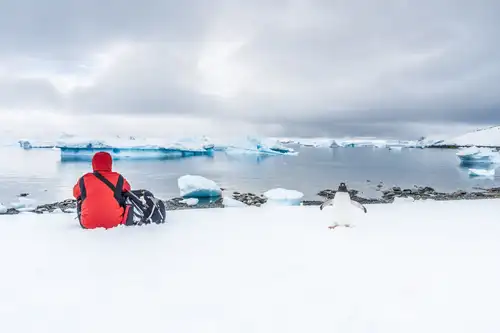Being one of the most remote islands on Earth gives St. Helena a unique allure. Named after a Roman empress and the mother of Constantine the Great, this island also holds the distinction of being Napoleon’s final place of exile, making it a fascinating topic of conversation.
All these attributes make St. Helena a captivating destination, perfect for a dinner party anecdote.

But St. Helena has much more to offer. This remote island in the South Atlantic is home to a rich variety of birdlife, vibrant flora, and lush hiking trails, among other attractions.
Even though St. Helena is outside our usual polar regions, here are five things we love about this enchanting island.
1. St. Helena’s birdlife (and marine mammals)
St. Helena is a haven for bird enthusiasts, designated as an Important Bird Area by BirdLife International. The island hosts breeding populations of noddies, petrels, terns, and tropic birds, along with its only remaining endemic bird, the endangered St. Helena plover, also known as the wirebird due to its slender legs.

Red-billed tropic birds, white terns, band-rumped storm petrels, Atlantic sooty terns, brown and black noddies, and Atlantic masked boobies are among the species that breed on the island.

While there are no endemic land mammals, the surrounding waters are frequented by seals and whales, including sub-Antarctic fur seals, southern elephant seals, minke whales, humpback whales, and southern right whales.
2. All the vibrant flora of St. Helena
Though the introduction of goats by Portuguese explorers in 1502 significantly reduced St. Helena’s endemic flora, many original species have made a comeback over the centuries.
Among these are the St. Helena redwoods, St. Helena dwarf ebonies, and black cabbage trees. These species are most commonly found in the high tree-fern thickets of the island’s central ridge areas, which can be explored during guided hikes.

Interestingly, the St. Helena dwarf ebony is not related to other ebony trees, and the St. Helena redwood is unrelated to the redwoods of California.
3. Jamestown and its Helena-specific charm
Jamestown, remote yet rich in history, has seen activities few places so far from mainland civilization can claim. Founded in 1659 by British East India Company colonists, the town initially served as a trade and communications outpost.
Over time, Jamestown became known for its Georgian architecture, its association with Napoleon Bonaparte, and its role as a British port crucial in rescuing slaves trafficked between Africa and the Americas.

The town features a concentration of Georgian-style buildings, including the Southern Hemisphere’s oldest Anglican church, built in 1772,

and a 699-step stairway known as Jacob’s Ladder, constructed in 1829.

Jamestown also played a significant role in the British interception of slave ships, saving an estimated 25,000 African prisoners before its closure in the 1870s.
Additionally, Jamestown was the second and final place of exile for Napoleon, who resided in Longwood House from 1815 until his death in 1821.

4. Napoleon’s St. Helena exile at Longwood House
One of history’s most ambitious military leaders, Napoleon Bonaparte, needed to be exiled twice. After escaping from his first imprisonment on the Mediterranean island of Elba, he regained control of France during the Hundred Days.
However, his power was short-lived as European allies defeated him at the Battle of Waterloo, leading to his second exile in 1815, this time to St. Helena. Napoleon lived at Longwood House until his death at the age of 51. Today, Longwood House serves as a museum.

5. Highland-and-lowland hiking on St. Helena
Exploring one of the world’s most remote islands on foot is an unparalleled experience, especially on the lush St. Helena.
From easy backcountry strolls to more challenging treks through deep valleys, isolated bays, and scenic cliff paths, hiking on St. Helena offers a variety of experiences. Detailed descriptions of the island’s numerous hiking routes can be found in guidebooks like "Exploring St. Helena: A Walker’s Guide" by Laurence Carter and Ian Matheson.

While not all routes from the guidebook can be covered due to the many other sites to visit, expedition guides will select the best paths available.
Whichever path you choose, you’ll be glad you explored the captivating island of St. Helena.
Blog



Cruising Solo: The Benefits of Single-Passenger Polar Travel

Seven Things to Do around Ushuaia

Two for the Snow: Polar Cruises for Couples

Get to Know Your Ice

Keep It Green: Our Commitment to Sustainable Polar Travel

5 Life Lessons You'll Learn in Antarctica

Navigating by touch through the sea ice

The Northern Lights dancing across the skies

Fierce and Feathered: the Skuas of Antarctica

11 Seals You May See in Antarctica or the Arctic

Path of Polar Heroes: Hiking Shackleton’s Historic Route

Taking a polar expedition cruise delivers no shortage of show-stopping highlights, but one of the most exhilarating is lifting off from the ship in a helicopter and taking flight over the incomparable Antarctic wilderness.

Taking the Polar Plunge

The Eight Great Penguin Species of Antarctica

The Seasons of Antarctica: When to Visit and Why

Port Lockroy: History, Post Office, and Resident Penguins

Greenlandic Inuit Beliefs

15 Toothy Facts About the Atlantic Walrus

The Norse Settlement of Greenland






